 A kelong visit with family or friends are always an enjoyable trip, to enjoy the outdoor, sea breeze, blazing hot sun, sea all around. These days the kelongs found in Sibu Malaysia are converted into a family resort style, no longer used to haul in fishes from the net. To spare you the agony of reading the history of kelongs, google for more info.
A kelong visit with family or friends are always an enjoyable trip, to enjoy the outdoor, sea breeze, blazing hot sun, sea all around. These days the kelongs found in Sibu Malaysia are converted into a family resort style, no longer used to haul in fishes from the net. To spare you the agony of reading the history of kelongs, google for more info.Back to fishing, whenever I visit kelong it is generally to fish. Heck, what could an angler ask for when he is surrounded by sea? So what can you expect to catch from a 'hut in the middle of the sea'?
What I can share with you is what I have learn from fellow anglers, who so unselfishly shared their knowledge with me. I should now in turn share with you almost everything I know about fishing at these beautiful kelongs, except for some closely guarded rigs which I am not suppose to share openly without their permission.
Instead of telling you what rig to prepare for a kelong trip, allow me to do things a little bit different here. I will put up some different species of commonly found fishes and the method to fish for them. There are usually hundreds of method to fish, and as a matter of fact I am still learning as always. But these are my usual methods whenever I want to specifically target for a certain species. Most method are using baits instead of artificial lures, as I am not experience in luring and kelong are a pretty tough place to lure due to the height where we will be fishing.
Comments are always welcome!!!
Rabbit fishes
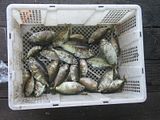 As far as I know, there are a few species of rabbit fishes, what are usually found in kelong are the white spotted ones. They usually school around the stilts of the kelong, but one particular place where they are usually found in abundance is the opening beside the kelong kitchen. They hang around the area as the kitchen will dump unwanted food into the sea and they feed on these.
As far as I know, there are a few species of rabbit fishes, what are usually found in kelong are the white spotted ones. They usually school around the stilts of the kelong, but one particular place where they are usually found in abundance is the opening beside the kelong kitchen. They hang around the area as the kitchen will dump unwanted food into the sea and they feed on these.Though rabbit fish are something I dun usually fish for as usually they are much smaller then those we find in the market. But at times when the weather get too warm and I needed some indoor fishing activities I will fish for them, further more, I would say give me that 'instant gratification' as they are easy to catch and fast to take the baits.
Warning
Rabbit fish have some venom in the spikes of their fins, the venom cannot kill you but am told that it could cause you considerable pain should you be pricked by it. Be careful when handling the fishes.
Rigs and Baits
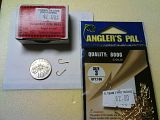 Small hooks in Paternoster, and by small I really mean small. I usually use Mustard Kirby Hook size 12 or 14, depending on what I have and Angler's Pal size 3 Tamban hooks. Have to use such small hooks as they do have really small mouths. Line used are usually 4lbs for the entire rig, but I have tried it with 2lb Dupont and it does holds up well too. Usually I do it in a 3 or 4 hook configuration as it makes it much easier for me to bait up, and have to do so very regularly. Alternatively, you can use those commercially available tamban rigs, either use all the 8 hooks or cut into half and use 4 hook each time.
Small hooks in Paternoster, and by small I really mean small. I usually use Mustard Kirby Hook size 12 or 14, depending on what I have and Angler's Pal size 3 Tamban hooks. Have to use such small hooks as they do have really small mouths. Line used are usually 4lbs for the entire rig, but I have tried it with 2lb Dupont and it does holds up well too. Usually I do it in a 3 or 4 hook configuration as it makes it much easier for me to bait up, and have to do so very regularly. Alternatively, you can use those commercially available tamban rigs, either use all the 8 hooks or cut into half and use 4 hook each time. Float is optional, if you intend to use, use those tiny ones that are used for prawn fishing, even the smallest styrofoam are too buoyant to detect the pull of these tiny fishes.
Float is optional, if you intend to use, use those tiny ones that are used for prawn fishing, even the smallest styrofoam are too buoyant to detect the pull of these tiny fishes.Any small lead weight will do the job, as you will fish just below the water surface.
An they are veggie eaters, so in actual fact any veggie should do the trick. Personally I prefer to use uncooked potato as it is easy to cut and firm enough to bait up easily. Corns kernel can be used too, simply DIY or buy a can of it (do not get those creamy type). Bread can be used too, but they break ups too easily in the water for me.
If you have some stale bread, bring it along to lightly berley your fishing spot when the school is too far away.
Method of Fishing
I usually fish for them during daylight hours, no idea how to do it at night. Maybe a slightly different method is required. Simply lower the baited rig to just below the water surface, fishes of all kind will start to go after the baits. As they are usually nibble at the bait instead of snatch and run, a lot of times you cannot feel the fish pulling, so what I did is that once I see that the specks of bait disappear, I give the rod a gentle jerk. Do it a few times to get the hang of it and before long you will be hooking them up. Though I have to warn that like all fishes, they will make a beeline for the stilts when they get hooked, that's where you will need to display a little of you angling skill to steer them away from the stilts.
This method yield comes to almost zero by-catches, other coral fishes will not take the baits, they prefer seafood. I would recommend anglers to use this method as there are little by-catches and is fun to fish with hooks and lines.
Some anglers prefer to foul hook them by berley the place and foul hooking them with umbrella hooks. I seriously will not encourage this method as 1) Heavy berley is required (to me is a waste of food that could be used human consumption) 2) Dangerous to anglers and those around him, many times I need the umbrella hooks shooting onto the kelong when the angler missed foul hooking the fish 3) This takes away the fun out of fishing, it is more like hunting rather then fishing.
Some other tips
How to unhook the fish safely - Get yourself a pail or basket from the kelong and arm yourself with a plier. Place the hooked fish into the pail and pull the main line until the fish is close to lips of the pail, get your plier and grip the hook, a few gentle shake will dislodge the fish safely from the hook and into the pail.
Wolf Herring (aka Saitoh, Ikan Parang)
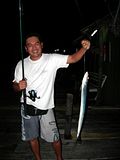 I simply love to fish for these wolf herring, not only they fight well (esp when you are using light tackles), they make good baits when you are hunting for biggies, and boy are they tasty after pan-frying them and served with dark soy sauce. However, after all these trips to kelong, sadly no one is willing to share with me how to identify the conditions when they are in abundance. Thus, I will have no choice to but give a general guideline, i.e. during nightfall. Most time I will start trying when the darkness falls and also throughout the night.
I simply love to fish for these wolf herring, not only they fight well (esp when you are using light tackles), they make good baits when you are hunting for biggies, and boy are they tasty after pan-frying them and served with dark soy sauce. However, after all these trips to kelong, sadly no one is willing to share with me how to identify the conditions when they are in abundance. Thus, I will have no choice to but give a general guideline, i.e. during nightfall. Most time I will start trying when the darkness falls and also throughout the night.Rigs and Baits
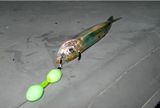 Single hook on a 2 to 3 ft long leader. Any range of medium sized hook can be used, since there is no standard hook sizes in the market, I will use Mustard Size 2 as a reference, any hook size around that can be used. Leader breaking strength will depend on your setup, again, I will give some reference on my setup used, noodle rod - 10lbs (8lb a tad too weak), fast action rod 15lbs to 200lbs.
Single hook on a 2 to 3 ft long leader. Any range of medium sized hook can be used, since there is no standard hook sizes in the market, I will use Mustard Size 2 as a reference, any hook size around that can be used. Leader breaking strength will depend on your setup, again, I will give some reference on my setup used, noodle rod - 10lbs (8lb a tad too weak), fast action rod 15lbs to 200lbs.Some anglers will insist of doing the rig with wire trace, think it is really up to the angler's choice really.
Anglers usually have some crazy ideas when doing up their rigs, show here is a rig with an added light stick which i come up with, not sure if it improves the catch rate, but it sure does not turn them off.
Tamban is the preferred bait of choice due to it's shiny body, in fact I think that's the only preferred bait of choice.
Method of Fishing
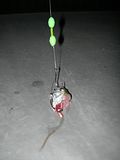 As you might notice I make no mention of lead weight when discussion rigging, cause there is no need for it. Cast your un-weighted tamban beyond the lighted area of the kelong and let the bait drift along letting out lines as the bait slowly drift away with the current. Once the wolf herring take your bait, they will start dashing away, this is where you will need to suppress your natural angling instinct. Most angler will go for the hook up once you feel the fish have taken the bait, but for wolf herring, you will need to let them run with your bait for a while. Then close the bail arm and go for the hooked up.
As you might notice I make no mention of lead weight when discussion rigging, cause there is no need for it. Cast your un-weighted tamban beyond the lighted area of the kelong and let the bait drift along letting out lines as the bait slowly drift away with the current. Once the wolf herring take your bait, they will start dashing away, this is where you will need to suppress your natural angling instinct. Most angler will go for the hook up once you feel the fish have taken the bait, but for wolf herring, you will need to let them run with your bait for a while. Then close the bail arm and go for the hooked up.Shown here in the pic is the remains of a bait after a failed attempt when we started out to fish for them, make the mistake of going for the hook up once the bite is felt.
Another popular method is to use metal jigs to hunt for wolf herring, jigs with a shiny body is the preferred choice. Just cast out the jig and retrieve with some twitching movement. For me it yields limited success, for some that's the only way to do it. Make your own choice on the method your prefer.
Some other tips
Do not assume that you can always get tamban when you rig for them at the kelong, many times we failed to get any, in the end to be safe, we bring some frozen tamban whenever we are going to kelong just to be safe.
Wolf herring have small shiny scales, handle them with cloths or newspaper, else after you handle the wolf herring, everything you touch will have some shiny sparkle on them.
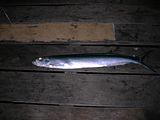
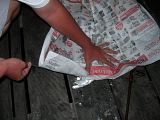
Todak
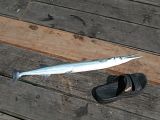 Some folks say nasty stuff whenever they see the amount of todak we caught during our kelong trips, like we should not kill so many of them, we should C&R, etc, etc. I make no apologies for catching them, as 1) They are consider a pest fish for a lot of anglers, 2) They are in abundance in our region, 3) They are not overfished by commercial trawlers because they are not a targetted species, 4) Yes, we do eat them or give them away to neighbours and friends and 5) They are damn fun to catch using ultralight tackle, providing the trills of at least a 10+ minutes period before we can bring in the decent sized one.
Some folks say nasty stuff whenever they see the amount of todak we caught during our kelong trips, like we should not kill so many of them, we should C&R, etc, etc. I make no apologies for catching them, as 1) They are consider a pest fish for a lot of anglers, 2) They are in abundance in our region, 3) They are not overfished by commercial trawlers because they are not a targetted species, 4) Yes, we do eat them or give them away to neighbours and friends and 5) They are damn fun to catch using ultralight tackle, providing the trills of at least a 10+ minutes period before we can bring in the decent sized one.Sometimes while we are fishing we heard stuff like 'Todak lousy fish, catch so many also useless', 'Todak so easy to catch, I catch them I throw them back', etc, etc. Haiz, what can I say, my own experience tells me to specifically target todak and to catch them on a regular basis is a tough job without the know-how. Thanks to my good fishing kaki, DesT, who teaches me almost everything I know about pelagic fishing on noodle rod, I have my fun and usually have a decent catch rate for todaks.
Thus, in case I am accused of providing info to wipe out the entire population of todak in SEA region, or teaching anglers to catch 'Useless' fishes, so easy to catch also need to teach meh, I will not be going into details on this one. Instead, all I can say to is, todak is a pelagic species, so use a float rig when you want to target them using small fishes as baits.
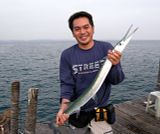
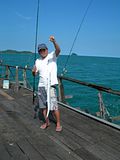


Squids
I have to admit, I am a very very lousy squid hunter. Maybe the worse squid hunter you have ever come across, only during one of my trip with Leon, an avid squid hunter, did I learn more about squid hunting.
Any Avid Squid hunters to help me on this section? Please do share your knowledge if you could
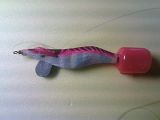 I usually try for squids only when I can spot them when they are near the surface, using a squid jig, cast beyond the squid and using to work to work the jig in an Up / Down movement to get their attention. They will attack the jig during it's downwards movement.
I usually try for squids only when I can spot them when they are near the surface, using a squid jig, cast beyond the squid and using to work to work the jig in an Up / Down movement to get their attention. They will attack the jig during it's downwards movement.I think it is usually the 'Green Eyes' cuttlefish are caught rather then the 'Arrowheads' at the kelong, no idea why is this so. But as long as I am concern, they are both fished with the same method, unless you can highlight to me.
Something for Newbies
Sometimes we do have non-fisho who visit the kelong with us, all they want is to experience catching some fishes. So what is like almost a 'sure catch' fishes? If I have a choice, I will want them to jig for bait fishes, so that bait fishes are available for the more serious fisho without having to jig for them. But sometimes bait fishes are just around and at times telling them how to jig can be quite a pain in the arse. Thus let them do some fishing using the traditional hooks and hooks.
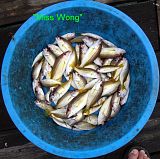
Small Leng Chaim and Small Miss Wong are always available around the kelong, simply just drop a paternoster jig using appox size 7 hooks with baits will do. Baits can be anything from the sotong the kelong provide or prawn meat, just just the sotong into thin strips and hook on one end will do the trick. I recommend the paternoster rig simply because it is more sensitive to detect fish bite, thus can set the hook faster thus hooking the fishes by it's mouth rather have them doing what I hate most, swallow the entire hook.
Best time to target them is at day break, but usually they are almost always available. Of course there are other coral fishes that can be caught this way, maybe baby groupers, Sergent Major, and so on. Tables sized Leng Chiam are available too, but I notice that they are usually caught further away from the kelong, thus need to cast out like 30m out and really wait for it.
Do release any unwanted fishes back to the sea please. Before I am accused of not preaching what I say with the photo of baby Miss Wong, let me clarify that we are using them for baits for our todak hunting as they are usually unwanted by anglers who are jigging for bait fishes.
Bait Fishes
Strangely enough, bait fishes are getting less and less at the kelong. Not sure if the effect of global warming have any effect on this but notice that where once upon a time, one can always get bait fish at the kelong, it is now like a game of poker, either have tons of it or none at all. Do bring along at least some if you intend to do some fishing at the kelong.
Tamban, Kunning and baby Miss Wong
Tamban is a baitfish that everybody want, think this shiny body got a lot to do it's popularity. Only way I know is to jig for them using tamban jig, just face the current and cast away. The effective one at the kelong are those commercially ones, like Anglers' Pal, Sea Hawk, etc, for some reason, our extremely popular BJT tamban jig is just not as effective. One other thing to take note of while buying the rigs, choose either white, green or a combo of both, sometimes they take white only, green only and at times everything also take. So get a few different type just to be sure.
Kunning and baby Miss Wong can also be jigged using the same method, only difference is the depth of the rig deployed.
Selar, 'Big Eyes' & Kembong
Actually they are not bait fish for me but a source of food to me, but seems that everyone classify them as bait fishes, I will do the same too. They are not found in abundance usually but once the monsoon session comes, they are found in huge numbers as they seek shelter from the rough seas. At general guide to when to fish for them is between Late Nov till Late Jan.
2 method to hunt for them, jig and bait. Pro and Cons to both method,
Baiting - Slower catch rate but much better percentage of larger fish.
Jigging - Super catch rate when they are around, but an assortment of sizes, very low chances of larger ones, like one per 25.
Commercially available Sabuki will do the trick for jigging for them, but the selar out-number the other 2 species greatly. Mustard worm jig is also another popular choice, but need a lot of arm power do fast jigging to be really effective. Baiting rig is a simple hook at the end of line, with a small split shot about 2ft from hook, bait is either a piece of prawn or strip of tamban flesh.
Others
While on the kelong, you can go for biggies like cobia, barracuda, queenie, stingray, etc. But these fishes are not always around, thus I will not go into details on them. Instead, what I have talk about are almost like 'sure catch' on the kelong, good fun for kids and newbies to catch their first fishes and with constant bite and catch rate to keep their interest. Might cover more on the biggies in the future.


0 comments:
Post a Comment